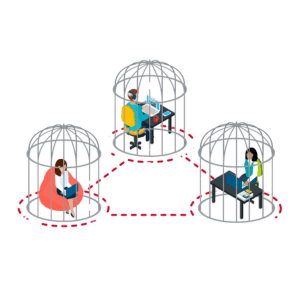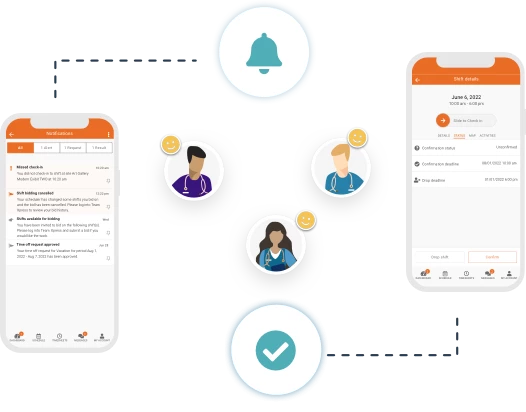“Effective teamwork begins and ends with communication”
Mike Krzyzewski.
Everything you accomplish at work is driven by team communication. Most people would be better off as self-employed if it weren’t for team communication. But why do we care so much about team communication? Why would a coworker want to know that you have an emergency dentist appointment on a Tuesday morning?
Any organization, be it a sports organization or an organization such as ours or yours, requires daily conversations and meetings to reach the ultimate goal: make a profit and increase the company’s value. But are these two factors correlated? It turns out they are!
Data indicates how expensive poor communication can be:
- Poor communication in the workplace accounts for an estimated loss of 7.47 hours per employee per week.
- For the average full-time knowledge worker on the team, earning $66,976, the wasted 7.47 hours each week adds up. This wasted time costs $12,506 per employee each year.
As a result, this blog describes the importance of team communication and gives tips on how an organization can quickly improve it.
What is Team Communication?

Open team communication is when people may freely share their views and ideas as a team. A company may communicate openly in a commercial context by encouraging all workers to voice their comments and thoughts. Employees may feel more valuable to the organization, boosting employee loyalty and productivity.
An employer’s communication strategy or style reveals a great deal about them as a leader. Are you, as an employer, calm and helpful as you lead your team through creative projects? Or are you more intense in your delivery, putting pressure on your team members to perform effectively and provide winning results?
Numerous communication methods exist, and ineffective communication skills can lead to poor performance and morale. Still not convinced? Our next section might help you understand why team communication is essential, and we have some statistics to prove it!
Why is Team Communication important?
Everything you accomplish at work is driven by effective communication. Project quality, stakeholder relationships, and customer happiness can all be traced back to how well your team interacts with one another.
Efficient decision-making, engaged team members, team collaboration and successful project managment all result from effective communication. Poor communication within your team, on the other hand, may result in the following:
- Imbalanced or duplicate work
- Disappointing project results
- Unsatisfied clients
- Poor customer feedback
- High team member turnover
- High-stress environment
- Low team member engagement
As you will find out, communication is detrimental to teams’ success. Here are the reasons why communication is essential in a team.
Builds healthy work relationships
It’s critical to connect with your coworkers in every company culture. According to research, happier employees are more productive. Therefore as a leader, you can’t go wrong by investing in team communication. According to the Connected Culture report, 71% of employees reported they are well-connected to their coworkers, and hence more productive.
People have psychological needs, such as the need to be understood, affirmed, and accepted. It does not alter a working culture. Healthy work connections may boost self-esteem and job happiness, promote employee retention and provide a more stable work environment.
Improves employee engagement

It is critical to have a clear, simple, and consistent set of communication procedures in place if you want to promote employee engagement in your workplace. According to a recent study, engaged employees are 17% more productive than their colleagues.
Employee misgivings are dispelled through effective team communication, which allows them to share ideas and concerns with their colleagues and management. Team communication fosters a recognition culture in the workplace. Employee recognition is an excellent approach to inspire and enhance morale.
Team members recognize each other’s successes when you develop a culture of excellent internal team communication. It fosters a sense of belonging among team members, keeping them interested and pleased.
Impacts employee wellbeing
Employee happiness is crucial to an organization’s success. If your employees are not physically and psychologically fit, their performance suffers. When employees lack regular communication with their colleagues and team leaders, their productivity might suffer. When team members feel devalued because they aren’t getting the required interactions, they become sick.
Furthermore, following the pandemic, the most global workforce has adapted to remote or hybrid work cultures. Employees who stated that their company provided feedback were 17% less likely to be anxious, according to Achievers’ study Empowering Employee Wellbeing in the New World of Work.
The abrupt move has altered workplace chemistry since employees can no longer connect in person, causing tension and worry. Employees remain emotionally healthy when they maintain open communication and share their experiences with any concerns. The idea is to find ways to bridge that gap and provide the appropriate distant communication tools.
Brings more innovation
Companies from all industries must discover inventive strategies to maintain and reinvent themselves in this digital economy. That can only be accomplished via effective communication and active listening.
A workplace usually consists of people from various backgrounds and nationalities. Their life experiences and viewpoints enable them to see an existing problem through fresh eyes.
We can only profit if they are permitted to create a culture of open communication. Creating an open corporate culture and encouraging workers to express their ideas and opinions allows businesses to make better decisions and innovate. Because open communication is a crucial feature that fosters innovation, it is unlikely to occur in an organization that lacks it.
Enhances transparency

People own and operate companies. And humans have an innate need to know things to assess and learn. Energy is shared in a company, and healthy connections are formed by promoting workplace openness. The worst thing for companies are information or communication siloes.
It’s unsettling to be surrounded by secrets and hidden knowledge, especially at work. Research suggests employee engagement may be improved by continuous and transparent communication.
All team members must keep each other informed and preserve openness to guarantee a smooth work process and the most significant results. Transparency would enable them to communicate successfully, offer constructive feedback, solve problems, and establish connections.
Develop employee skills
A team unable to communicate appropriately cannot work at its best. Team members that operate in a collaborative atmosphere or cross-functionally improve their talents.
Collaboration helps your staff to learn and get insights from their colleagues, which is critical for enhancing their talents. Effective communication among team members allows for a more accurate assessment of their abilities and performance. It shows you how and where you need to improve your knowledge.
Reduces conflicts
85% of employees have some conflict throughout their time at a company, with ego and personality clashes accounting for 49% of them. – Pollack Peace Building
Workplace conflicts are unavoidable. It can occur when two persons involved in events or circumstances cannot reach an agreement or accept a result. Internal and external disputes can also result from clashes of ideas, miscommunications, or an unwillingness to acknowledge one another. 85% of employees have some conflict throughout their time at a company, with ego and personality clashes accounting for 49% of them.
Conflicts occur, and most individuals do not know how to avoid them via efficient communication. Effective communication leads to more fruitful discussions and better planning. It enables workers to examine a disagreement rationally without becoming emotionally involved. It also increases the chances of healthy collaboration among team members.
Now that we know why team communication is so important, let’s explore how you can improve team communication in your organization.
Maintain an open-door policy – it fosters confidence.
An open-door policy establishes the precedent that anybody, at any time, can ask questions, voice concerns, and propose ideas. This is an essential aspect of establishing trust within your team. Making management unavailable communicates to lower-level employees that they are less valued. It is critical to keep communication channels open.
While you’re opening metaphorical doors, you should also open actual ones. Removing physical barriers between colleagues fosters confidence and facilitates the uninhibited sharing of ideas. Instead of waiting for the weekly business meeting, problems can be reported and resolved as they arise.
Constructive criticism is intended to be precisely that: constructive. Feedback must be understood by all parties involved. A simple “fix this” in response to a project submission isn’t useful to anyone. Feedback must be precise and thorough to be effective.
Bonus points if it’s openly (and politely) documented so that others may also learn from it. Also, don’t forget to take input! Because no one is flawless, we all require constructive criticism from time to time.
Make tasks clear so that everyone understands their responsibilities.

Nobody can adequately finish an assignment if they are unaware of the tasks they are responsible for. Ascertain that the whole team understands the scope of the project and that each team member understands exactly what is expected of them.
Here are some examples of how to convey individual task responsibility:
- Bring the team together frequently, either by video or in person, to check progress, ask questions, and handle any difficulties. Aside from having a general meeting, it’s good to see everyone’s faces now and then!
- Participate in one-on-one sessions to ask staff how they are doing and ensure they are aware of what is happening.
Do something enjoyable to increase morale.
Team-building exercises have long been used to increase team communication. But instead of role-playing or other boring office activities, gather the group and play cards (without gambling, of course). Once a month, throw an after-work pizza party. Install some board games in the break area.
An escape room is a fun, casual game that promotes collaboration. Many cities have them, and some even provide discounts to workgroups. When coworkers are at ease, they naturally communicate more effectively. The sensation of belonging to a “work family” motivates most individuals to work harder toward a common goal and fosters a strong sense of reciprocity.
Make coffee breaks more meaningful.
In the spirit of team-building, a scheduled coffee break for all employees allows everyone to mingle informally while still at work. Coffee is the fuel most people need to get through the day, so why not make it pleasurable and productive simultaneously? According to research, conversation over coffee, whether work-related or not, fosters good communication among coworkers and facilitates the exchange of ideas.
Communication training helps reinvigorate your team.
Yes, it exists, and it can be pretty successful at boosting group communication. Communication training entails more than simply fundamental conversational abilities. Depending on the course, it might involve training in presentation skills, business writing, and management abilities. These courses might be expensive, but the benefits far surpass the costs when your company runs smoothly.
Determine which modes of communication are most effective.

There are countless forms of communication that can be used when it comes to team communication.
The most obvious, and probably the most important is verabl communication! For the majority of workers, this is what they will use every day to communicate tasks, progress and just to socialise in the work place. As a manager, it’s important to encourage verbal communication and use it as a tool to resolve conflict, build trust, encourage engagement and lead team meetings.
For “traditional” workers in the corporate world, written communication comes in a close second to verbal communication. Emails, messaging, project briefs are all managed with written communication. However in some cases, using verbal communication to back up your written communications can be a great way to ensure details are clear and everything is being handled.
Occasions exist where the mode of communication is vital, such as in discipline or conflicts. In these cases verbal communication is always recommended as it avoids crossed wires, and unclear delivery.
Recognize diversity concerns
Unique ideas come together to produce something extraordinary when people of many ethnicities, races, philosophies, and languages interact. However, diversity is not without its difficulties. Accents, subtleties, dialects, and cultural colloquialisms may make it difficult to communicate clearly.
To overcome these challenges, team leaders must first identify a problem. Sweeping these types of concerns under the rug, while it may be difficult for some, does no one any good. Make it a point to be upfront with your team members about the situation and explore possible solutions.
Identify and capitalize on individual abilities.
Remember that not everyone prefers to communicate in the same manner. Visual individuals prefer written communication (email or cloud-based software), whereas auditory people prefer phone calls, video chats, or face-to-face meetings.
Recognizing that everyone is unique allows for better communication. It communicates to your team members that you regard them as people and understand whatever type of communication works best for them. A valued team member is prepared to go above and beyond for the firm.
Communicate openly and honestly with your team members.
Instilling trust in your team members is maybe the single most effective strategy to increase interpersonal communication in the workplace. Transparency is essential here; if team members believe secrets are being withheld from them, whatever trust you have gained will be lost. Of course, sensitive material should be treated as such, but team members have a right to know when such information is unavailable.
Maintain open and honest communication with your team members, and reassure them that they can do the same with you. Mutual trust is essential in any connection, especially professional relationships.
Create a good working atmosphere.

Nobody wants to work in an office full of zombies with no interests except for work. Not only does this lower morale, but it is also detrimental to productivity.
People who feel like they’re just grinding it out daily aren’t as productive as they could be if they were engaged. Let them take a mental break by letting them know it’s alright to chat about subjects other than work while at work.
This isn’t to say you should go full Silicon Valley and stock the office with beanbags and free beer. It also does not imply that workers should not get their work done, but allow your team to socialize over lunches, coffee breaks, and water cooler breaks.
Different teams have different communication issues, and they approach them in different ways, but there are a few universal concepts that apply to all:
- Choose your tools wisely.
- Make it clear when and how each tool should be utilized.
- Use those tools regularly and appropriately.
- Consider how your words (whether written or spoken) could be understood.
- Be considerate of other people’s time.
You’re on your way to successful communication when you have the correct foundation and a culture that supports transparency and honesty. The concepts are simple and common sense, but putting them into action requires a genuine commitment from the entire team, from top to bottom. We have a blog on short team-building activities that your organization could perhaps do to increase collaboration and engagement.




